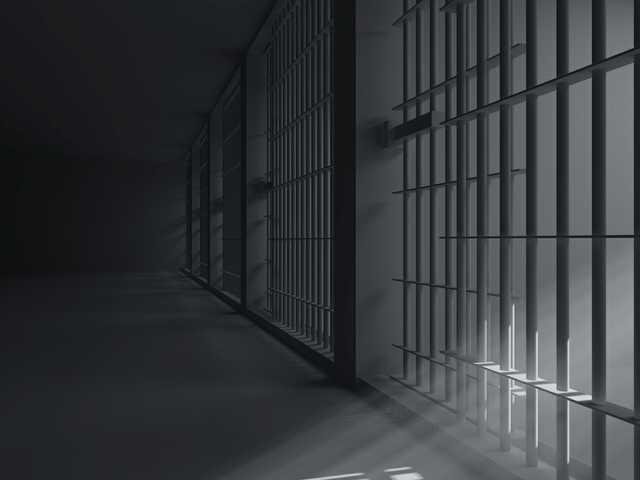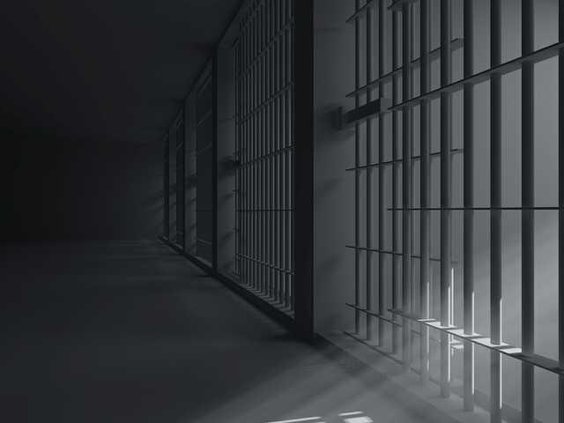A new report by the American Academy of Arts and Sciences makes the case that state investment in higher education has fallen dramatically over the past decades. Many states are now contributing only a small fraction of the cost of "state" colleges and universities.
One finding in particular stood out: there are now 11 states that spend more on prisons than on higher education. It's an arresting factoid, so to speak. But it could also be deceptive.
To dig into those numbers, we looked at the 11 states on the list, plus four large states that weren't on the list: Louisiana, Texas, Florida and California, as comparisons.
In each, we compared the state to the national average on five measures: incarceration rates, per prisoner spending, higher-education spending per capita in 2013 and the change in higher-education spending per student from 2008-14. In every case, the numbers are expressed as the percent higher or lower than the national average.
We found that beneath the headline, those 15 states actually were quite varied. Some clearly underinvest in higher education, while others have high incarceration rates. Some states balance high incarceration rates by spending very little per prisoner, with troubling policy implications in its own right. Other states have low incarceration rates but still make the blacklist because they spend more per prisoner while underspending on higher ed.
Some of the states that underspend will surprise you. Reputations do not always match reality.
Louisiana
Louisiana is a high-crime and high-incarceration state, especially the latter. But it spends far less than the national average per prisoner. Meanwhile, the states higher-education investment exceeds the national average. Combining very low investment per prisoner with a near-average educational investment keeps Louisiana off the blacklist. Somehow the state managed to hit that average despite dramatically slashing higher-ed spending during the Great Recession.
Texas
Texas has high incarceration rates without having that much violent crime. It avoids the blacklist by exceeding the average on higher-ed investment while spending much less per prisoner. During the recession, Texas actually cut its higher education spending less than most states.
Florida
Florida is a bit of an anomaly, with crime rates well above the national average but incarceration rates at a more moderate level. Per prisoner spending is also very low, which cancels out well-below-average higher-ed spending and steep cuts during the recession. Florida avoids the blacklist.
California
The largest state in the nation, Californias crime is on average not extreme, but its incarceration rate is much lower than the national average. Meanwhile, the state spends nearly half again per prisoner than the norm. This is a bit surprising, given that the state has been targeted by federal courts for overcrowding and poor prisoner treatment. But California stays off this blacklist by spending 19 percent above average on higher ed. Californias higher-ed cuts during the recession were much smaller than the norm.
Michigan
The blacklist begins here. Like Florida, Michigans crime rate is well above average, but its incarceration rate is modestly lower than average. Spending per prisoner is 13 percent below average. Thats not enough to outbalance being 18 percent below average on per capita higher-ed spending. Higher-ed spending cuts during the recession were also steeper than most.
Oregon
Oregon is one of several surprising members of the dishonor roll. With a crime rate 31 percent below average and incarceration rate also well below, Oregon gets in trouble by spending markedly above average per prisoner while also underinvesting in higher education by 24 percent compared to the norm. During the recession, the state slashed higher-education investments 61 percent more than the average.
Arizona
Arizona is somewhat above average on crime, though incarceration levels are higher still. The state markedly underspends per prisoner. On higher education, the state falls not too far below the norm per capita, even though it slashed its investments dramatically during the recession.
Vermont
Vermont is probably the oddest duck in this pond a liberal, tiny rural mountain state with crime rates and incarceration rates way below the national average. But it makes the list with the double whammy of very high per prisoner investment and very low higher-education spending, though its recession cuts were more moderate than most other states.
Colorado
With crime and incarceration rates well below average, and per prisoner spending near average, only one number jumps out for Colorado higher-ed spending that falls a whopping 49 percent below the norm. Cuts during the recession were modest, however.
Pennsylvania
Pennsylvania is another state with nearly normal crime levels and relatively low incarceration levels. But it suffers from markedly high per prisoner spending set against much lower than normal higher-education investment.
New Hampshire
New Hampshire has minimal crime and low incarceration rates. Spending per prisoner is near normal, and the state only makes the blacklist because it falls a full 75 percent below the national average on per capita higher-ed spending.
Delaware
Delawares crime rates are quite high, but incarceration rates are not. Spending per prisoner is average, and spending per capita on higher ed is low but not extremely low. This tiny states inclusion on the blacklist appears to be something a quirk. Delaware appears to be fairly average on the measures that matter.
Rhode Island
Rhode Island has low crime and even lower incarceration rates, but it spends much, much more per prisoner than the average. That combined with very low investments in higher education puts it on the list.
Massachusetts
Massachusetts incarceration rates are very low, but spending per prisoner is very high. But higher-ed spending per capita is surprisingly low against the national average, and the state aggressively slashed those spending levels during the recession.
Connecticut
There's low crime, low incarceration, but high per prisoner spending here. Higher-education spending per capita is very close to the national average. This is one state, more than any other, where higher per prisoner costs seem to be the driving factor.
Sources:
1. Federal Bureau of Investigation
2. The Sentencing Project
3. National Institute of Corrections
4. State Higher Education Executive Officers
5. Center on Budget and Policy Priorities
One finding in particular stood out: there are now 11 states that spend more on prisons than on higher education. It's an arresting factoid, so to speak. But it could also be deceptive.
To dig into those numbers, we looked at the 11 states on the list, plus four large states that weren't on the list: Louisiana, Texas, Florida and California, as comparisons.
In each, we compared the state to the national average on five measures: incarceration rates, per prisoner spending, higher-education spending per capita in 2013 and the change in higher-education spending per student from 2008-14. In every case, the numbers are expressed as the percent higher or lower than the national average.
We found that beneath the headline, those 15 states actually were quite varied. Some clearly underinvest in higher education, while others have high incarceration rates. Some states balance high incarceration rates by spending very little per prisoner, with troubling policy implications in its own right. Other states have low incarceration rates but still make the blacklist because they spend more per prisoner while underspending on higher ed.
Some of the states that underspend will surprise you. Reputations do not always match reality.
Louisiana
Louisiana is a high-crime and high-incarceration state, especially the latter. But it spends far less than the national average per prisoner. Meanwhile, the states higher-education investment exceeds the national average. Combining very low investment per prisoner with a near-average educational investment keeps Louisiana off the blacklist. Somehow the state managed to hit that average despite dramatically slashing higher-ed spending during the Great Recession.
Texas
Texas has high incarceration rates without having that much violent crime. It avoids the blacklist by exceeding the average on higher-ed investment while spending much less per prisoner. During the recession, Texas actually cut its higher education spending less than most states.
Florida
Florida is a bit of an anomaly, with crime rates well above the national average but incarceration rates at a more moderate level. Per prisoner spending is also very low, which cancels out well-below-average higher-ed spending and steep cuts during the recession. Florida avoids the blacklist.
California
The largest state in the nation, Californias crime is on average not extreme, but its incarceration rate is much lower than the national average. Meanwhile, the state spends nearly half again per prisoner than the norm. This is a bit surprising, given that the state has been targeted by federal courts for overcrowding and poor prisoner treatment. But California stays off this blacklist by spending 19 percent above average on higher ed. Californias higher-ed cuts during the recession were much smaller than the norm.
Michigan
The blacklist begins here. Like Florida, Michigans crime rate is well above average, but its incarceration rate is modestly lower than average. Spending per prisoner is 13 percent below average. Thats not enough to outbalance being 18 percent below average on per capita higher-ed spending. Higher-ed spending cuts during the recession were also steeper than most.
Oregon
Oregon is one of several surprising members of the dishonor roll. With a crime rate 31 percent below average and incarceration rate also well below, Oregon gets in trouble by spending markedly above average per prisoner while also underinvesting in higher education by 24 percent compared to the norm. During the recession, the state slashed higher-education investments 61 percent more than the average.
Arizona
Arizona is somewhat above average on crime, though incarceration levels are higher still. The state markedly underspends per prisoner. On higher education, the state falls not too far below the norm per capita, even though it slashed its investments dramatically during the recession.
Vermont
Vermont is probably the oddest duck in this pond a liberal, tiny rural mountain state with crime rates and incarceration rates way below the national average. But it makes the list with the double whammy of very high per prisoner investment and very low higher-education spending, though its recession cuts were more moderate than most other states.
Colorado
With crime and incarceration rates well below average, and per prisoner spending near average, only one number jumps out for Colorado higher-ed spending that falls a whopping 49 percent below the norm. Cuts during the recession were modest, however.
Pennsylvania
Pennsylvania is another state with nearly normal crime levels and relatively low incarceration levels. But it suffers from markedly high per prisoner spending set against much lower than normal higher-education investment.
New Hampshire
New Hampshire has minimal crime and low incarceration rates. Spending per prisoner is near normal, and the state only makes the blacklist because it falls a full 75 percent below the national average on per capita higher-ed spending.
Delaware
Delawares crime rates are quite high, but incarceration rates are not. Spending per prisoner is average, and spending per capita on higher ed is low but not extremely low. This tiny states inclusion on the blacklist appears to be something a quirk. Delaware appears to be fairly average on the measures that matter.
Rhode Island
Rhode Island has low crime and even lower incarceration rates, but it spends much, much more per prisoner than the average. That combined with very low investments in higher education puts it on the list.
Massachusetts
Massachusetts incarceration rates are very low, but spending per prisoner is very high. But higher-ed spending per capita is surprisingly low against the national average, and the state aggressively slashed those spending levels during the recession.
Connecticut
There's low crime, low incarceration, but high per prisoner spending here. Higher-education spending per capita is very close to the national average. This is one state, more than any other, where higher per prisoner costs seem to be the driving factor.
Sources:
1. Federal Bureau of Investigation
2. The Sentencing Project
3. National Institute of Corrections
4. State Higher Education Executive Officers
5. Center on Budget and Policy Priorities








